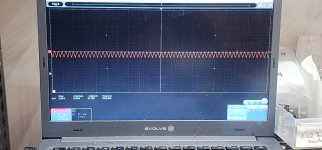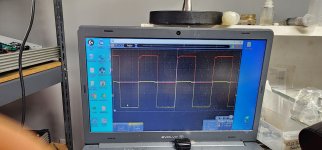This amp powers up and functions but the output fets heat unevenly between sides. One side stays cool while the other will get up to 120f at idle.
I removed the fet fets from the side that was heating up and I'm seeing a weird triangle wave on the output fet pads that should have nothing on them.
I removed the fet fets from the side that was heating up and I'm seeing a weird triangle wave on the output fet pads that should have nothing on them.
Attachments
What would cause one side to heat up? They all heat up evenly.
I already changed out the both 21844s chips and replaced all the drive transistors.
I already changed out the both 21844s chips and replaced all the drive transistors.
Are you using the same exact part number for a replacement?
Both halves of the amp have FETs from the same batch?
From a reputable distributor?
Bad component in the output filter?
Do the drive signals for both halves of the amp look exactly the same?
Both halves of the amp have FETs from the same batch?
From a reputable distributor?
Bad component in the output filter?
Do the drive signals for both halves of the amp look exactly the same?
Yes both drive waves look the same.
The only weird thing I can see is that
One side starts switching a full second before the other side
The only weird thing I can see is that
One side starts switching a full second before the other side
Where do the two ICs start oscillating vs the voltage on pin 2? It's normal for them to start oscillating at about 2v (referenced to the negative rail).
What's wrong with the waveform?
What jumps then goes back to ground? The IC can't produce output with pin 2 at ground (negative rail).
What jumps then goes back to ground? The IC can't produce output with pin 2 at ground (negative rail).
With your multimeter, yes.
Unless you have an isolated version of the owon scope, you can't reference the negative rail with it unless you use it in differential mode.
Unless you have an isolated version of the owon scope, you can't reference the negative rail with it unless you use it in differential mode.
With the isolated version, you can look at the drive signal by connecting across the gate and source for either the high or low-side. Remove the second probe from the scope. If you don't, realize that its ground (at the tip of the probe) will have rail voltage or rail-rail oscillation on it when probing the gate/source with the other probe.
- Home
- General Interest
- Car Audio
- Twisted Sounds 3.5k

